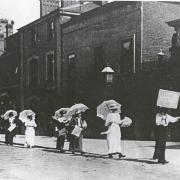The death of the Cockthorpe born naval man remains shrouded in mystery. Chris Armstrong reveals more about Nelson’s predecessor

Visitors arriving in Norfolk by road are greeted by a sign welcoming you to ‘Nelson’s County’. Indeed it is, but selecting just Nelson for acknowledgement seems a little mean. Nelson’s glory shines so brightly that it seems to have blinded us to the achievements of our other naval heroes. Over a century before Nelson, Norfolk boasted a trio of such heroes; the colourful Sir Christopher Myngs, Sir John Narborough and their Cockthorpe born protégé, Sir Cloudesley Shovell, a man whose death still remains shrouded in mystery today.
The night of October 22, 1707, was one of great storms off the Scilly Isles. Approaching the isles, heading for home, was an English flotilla under Shovell’s command.
The seas around the islands were notoriously dangerous – but profitable for the islanders. Some years earlier the governor of the Isles had even opposed the building of a lighthouse because the reduction in the number of wrecks which might result would be an economic disaster for his territory, which depended on salvage.
That evening Shovell was in far more danger than he realised - the weather had prevented new sightings being taken that evening but those of the previous day, and the soundings taken by lead weighted lines, led Shovell to the conclusion that he could safely turn into the Channel. But his position seems to have been further west than he had calculated and this error of judgement led directly to the wrecking on rocks of six of the 21 ships his flotilla comprised, four being sunk, including his flagship, the Association, with the loss of all but one of its crew of more than 1,300 sailors.

Shovell was washed ashore, temporarily buried locally, but disinterred and transferred to Westminster Abbey where he was accorded a hero’s funeral with 100 carriages following the hearse. Queen Anne, a great admirer of Shovell, arranged in his memory a 20-foot-high marble monument in the abbey with an epitaph describing him as ‘deservedly beloved of his Country and esteemed, tho’ dreaded, by the enemy who had often experienced his conduct and courage’.
But it’s not his funeral which is the main interest in Shovell, nor even his remarkable career- littered with Hornblower-type small boat attacks on the enemy, but what happened between the time when the Association foundered and the arrival of his remains at the abbey. The question, still not fully settled today is – did he drown, or was he murdered?
According to tradition Shovell abandoned the sinking Association in a lifeboat accompanied by his two stepsons and a pet dog. The website of Westminster Abbey is unequivocal – he was, they say, murdered. Having been washed ashore about six miles from the site of the wreck he was, just, alive, when he was discovered by a local woman, who seeing that he was wearing a large emerald ring, killed him and made off with the emerald.
The story goes that some 30 years later, and now on her own death-bed, she confessed to a priest the facts of her crime, entrusting him with the stolen ring to ensure its return. And Westminster Abbey is not alone in its assertion. In 1883 a paper was read to the Society of Antiquaries by J H Cooke FSA which cites a number of contemporary sources to assert that not one, but two rings were missing when the body was recovered and that Shovell’s widow offered a substantial reward for the return of the emerald, without success.

What seems indisputable is that when Shovell’s remains were interred the emerald ring, originally a gift to Shovell from the Berkeley family, was missing, and a story grew that the minister who had heard the deathbed confession of the alleged thief had duly returned it to the Earl of Berkeley.
The Norfolk man who ‘invented’ OMG!
Over the years, doubts have grown as to the veracity of the story. The ring itself has not been seen and it seems unlikely that if Shovell, a somewhat portly figure in his 50s, had been washed ashore in a lifeboat accompanied by his two healthy young stepsons, he should have been the one to survive when they did not. Above all there is no means of validating the story of the deathbed confession of the alleged murderer, said to have carried out her crime by smothering his face with sand.
Whether the story is apocryphal or not, nothing should detract from Norfolk’s pride in its ‘other Admiral’. Shovell was successively the protégé of two other famous Norfolk Admirals. First, the colourful Sir Christopher Myngs who combined with the notorious buccaneer Henry Morgan to wreak havoc on the Spanish in the Carribbean. Myngs was prone to sailing close to the wind, at least metaphorically. He was charged with embezzlement when, directly against orders, he arrived at a private arrangement with his buccaneer partners to split between them a bounty of £250,000. Fortunately for Myngs his recall to face charges coincided with the restoration of the monarchy and the case did not proceed.
After the death of Myngs, who must have been an inspirational figure, Shovell came under the patronage of Sir John Narborough, an outstanding officer moving rapidly up the ranks, eventually to be Commander-in-Chief.
Under Narborough’s command, Shovell was responsible for a number of actions, once personally commanding a daring boat raid at Tripoli. Narborough had been blockading the port for over a year seeking to arrive at an accord with the Dey (governor) to limit the activities of the Barbary pirates operating from there, but only stalemate had resulted. Shovell, having devised a plan, led a night-time raid into the harbour, setting fire to and sinking four of the ships anchored there before leading out his small party without any loss or injury.
He was later to demonstrate his tactical skills in another small boat operation when he led a further raid, this time in Dublin Bay. The French, in support of the deposed King James ll were landing men and materiel for James’s planned invasion of England. One of the French funded flotilla had run ashore at low tide and Shovell, using the ruse of appearing to prepare a fire ship to set her alight, induced the crew to abandon her. He promptly boarded the ship, and, while fighting off spirited attempts to re-take her, managed to lighten the ship enough by casting overboard all extraneous material to be able to sail her off as the tide came in, under the noses of the furious French.
And it was not just in small boat actions that Shovell earned his high reputation. At the Battle of Cape Barfleur he pre-empted Nelson’s tactic at Trafalgar by sailing his flotilla in single file straight through the French line of battle, causing chaos which enabled the rest of the British fleet to join him in inflicting a major defeat. Nelson of course, with a larger command, cut the French line at Trafalgar in two places rather than Shovell’s one. Perhaps Shovell’s action might, borrowing wrestling parlance, be described as a ‘half-Nelson’!
Shovell died a rich man – in 1691 he married the widow of his patron John Narborough, who had died - as did many other English sailors and soldiers – of a tropical disease while serving in the Caribbean. She was wealthy in her own right – on the death of her father she inherited a fortune worth, in today’s money, something approaching £15,000,000 – but when Shovell died she lost not just her second husband but also the two sons of her first marriage, both officers on the Association.
Norfolk should be proud of its ‘other admiral’. He was a man of exceptional energy and tactical skill, and much loved and admired by his men not least for his personal and hands-on style of leadership. Only one person seems seriously to have had reservations about him, Samuel Pepys. Pepys once described him as a ‘poltroon’ and sought to have him court-martialled for what he saw as behaviour unbecoming ‘a gentleman’ for acceding to a Spanish admiral’s insistence in Cadiz that his flag be saluted.
The totally outgunned Shovell, having first refused to do so subsequently fired the salute, in response to a threat from the Spanish to blast his ship to pieces if he did not. Pepys was to be disappointed, Shovell’s action was seen by others as a common sense response. It would be interesting to know what lay behind the apparent personal animus that Pepys bore him – perhaps Shovell was too demanding in his requisitions to the Admiralty for the frugal Pepys.
And if Shovell remains unacknowledged on Norfolk’s welcome signs, he does hold one distinction denied to Nelson. In 2008 his name was adopted by a heavy metal band – perhaps, given his use of cannon, an appropriate salute.
About the author
Chris Armstrong is the author of a number of books on Norfolk characters and businesses. Mustard, Boots and Beer tells the stories of a group of Norfolk’s 19th century businessmen, including Colman, Caley, and Bignold, while Anything from a Pin to an Elephant traces the history of some of Norfolk’s most iconic department stores – among them Jarrold’s, Bakers of Holt, Roys of Wroxham and Palmers of Yarmouth. His most recent book, Scholars, Saints and Sinners features the stories of a number of Norfolk’s more colourful clergy, including Harold Davidson of Stiffkey, and the notorious Arthur Loftus, Rector of Fincham who, having sued his wife for restitution of conjugal rights, recruited his domestic staff from a Wisbech brothel, sharing their favours with his manservant, as well as a number of equally interesting but less controversial clerics.
Chris is also the author of the recent Poppyland publication Wroxham, Capital of the Broads and the Editor of Under the Parson’s Nose, the third set of extracts from the diary of his great grandfather, the 19th century vicar of East Dereham, to be published.




























